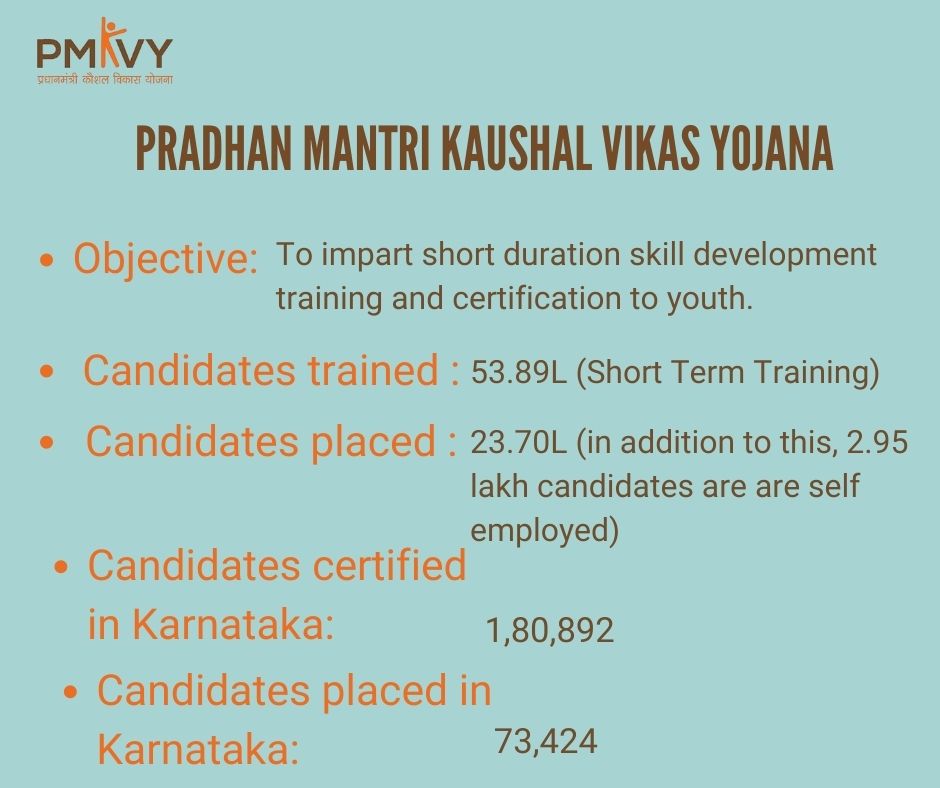Only 32 percent of the trained individuals have been placed till now; quality of skills imparted remains a challenge.
The placement rate under the Pradhan Mantri Kaushal Vikas Yojana (PMKVY), a scheme under Skill India Mission, stood at 32 percent in Karnataka, lower than the national average of 43 percent.
According to an official from the Ministry of Skill Development and Entrepreneurship, the quality of the skills imparted remains one of the significant issues in implementing the scheme. The official said that “National Skill Development Corporation (NSDC) selected the training partners for the scheme where the candidates are being trained. But a proper study on the efficiency of these centers was never conducted.” Each district has one Pradhan Mantri Kushal Vikas Kendra dedicated to the scheme.
Namita, a 27-year-old woman who has been unemployed for a year now said that the software skills imparted in the centre form where she completed her course were average. “We did learn Corel Draw, Adobe and InDesign but these applications were taught on a moderate level.” She said that they wanted to learn Premium Pro but it was not taught. These days recruiters demand User Experience Design (UX) and User Interface Design (UI) software skills which are also not taught during the course.
Under the Skill India mission, Ministry of Skill Development and Entrepreneurship (MSDE) started PMKVY in 2015. It is a skill initiative by the government with an objective to impart short-duration skill development training and certification to youth and to make them employable for better livelihood across the country.The scheme wrapped up its third phase i.e. PMKVY 3.0 (2020-22) last year. Twenty-one percent of funds have been distributed to Karnataka out of the sanctioned limit of approximately Rs.100 crores.

PMKVY has two training components, namely, Short-Term Training (STT) and Recognition of Prior Learning (RPL). Under PMKVY, placement opportunities are being provided to STT-certified candidates, while RPL is not linked with placements as it recognizes the existing skills of the candidate.
“RPL candidates constitute a major chunk of this scheme but the percentage of their placement is low because they are not given training from scratch,” said the official from the Ministry of Skill Development and Entrepreneurship. RPL candidates are candidates with prior learning experience and skills and they often go back to their pervious jobs after improving their skillset under the scheme.
The high dropout rate is another concern for policymakers according to another official from Ministry of Skill Development and Entrepreneurship. Prem Kumar, a vocational instructor at National Skill Training Institute (NSTI) for women said, classes were conducted from 10:00-2:00 pm which were the working hours of employees and the college hours of students. He added that “Many candidates drop out as the timings don’t suit many college-going students. Even, people who are already working struggle to manage their schedule so they eventually throw in the towel.”
The official said that the department had slightly changed its approach now. “There is a stigma associated with short-term training as recruiters find it hard to believe that a candidate can gain the required level of expertise in a few months,” said the official. Therefore, the department is now making the companies aware of the quality of the skills they provide to ameliorate the placement process.
Prem Kumar said that the NSTI he was working in did have an in charge for placements. But Namita who was trained in the same institute said she never came across such an in charge. The skill training partners are paid in installments by the government and submit a quarterly report of the students placed. The last 20 percent of their remuneration is paid to them only when all the students training under the scheme from the institute are placed.
The official also mentioned that not all people wanted jobs and therefore many of them didn’t sit for the placement drive. Vasantha, a 29-year-old woman working in an IT Company said she didn’t participate in the placement drive because she was not looking for a job in the course she took. “I joined the course because I just wanted to strengthen my skills,” she said.
One of the candidates who got placed through the scheme appreciated it. Preeti Verma, a 29-year-old woman who completed her course in mechanical CNC (Computer Numerical Control) said that she got placed in July through the scheme and was satisfied with the job.
Swapnil Dewalwar, a specialist in creating diverse and inclusive hiring for corporates said “The issues with PMKVY have been easy empanelment of too many training partners, lack of due diligence to check the competency of these partners to provide employment and poor monitoring, to name a few.”
He suggested that the policymakers should have done it in a reverse manner, and instead of training, first, they should’ve reached out to the industry and identified the manpower requirements, and then they should have selected partners who could undertake that sector-specific training, involving the industry in this training to some degree. He said this would have created employment opportunities in real-time.




